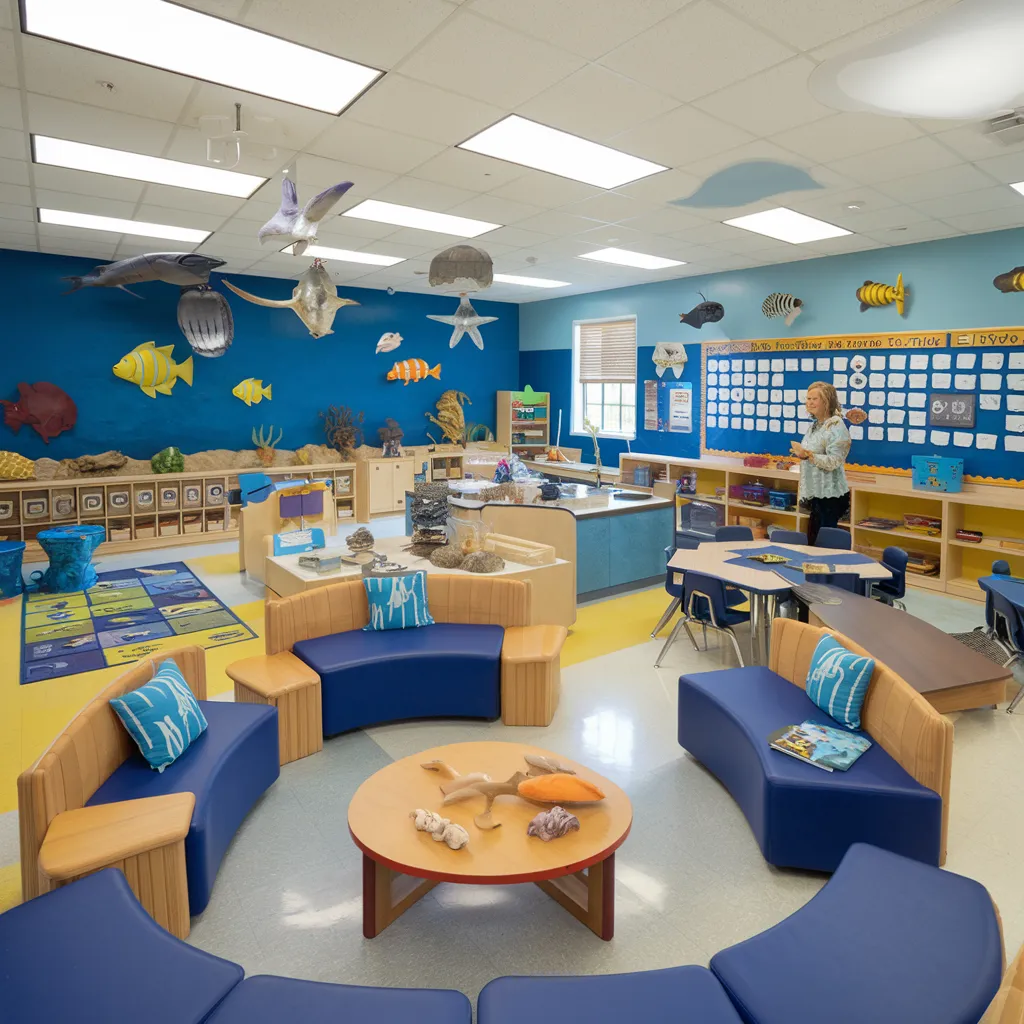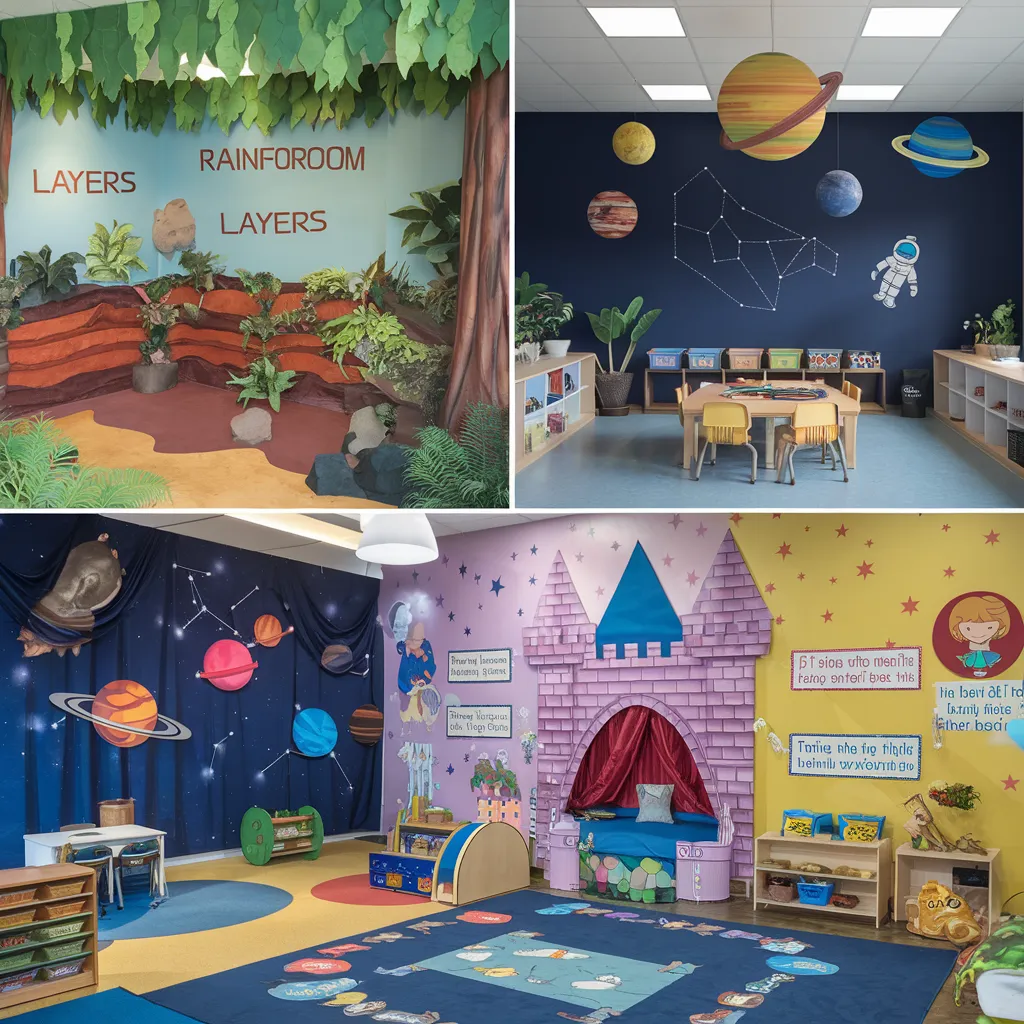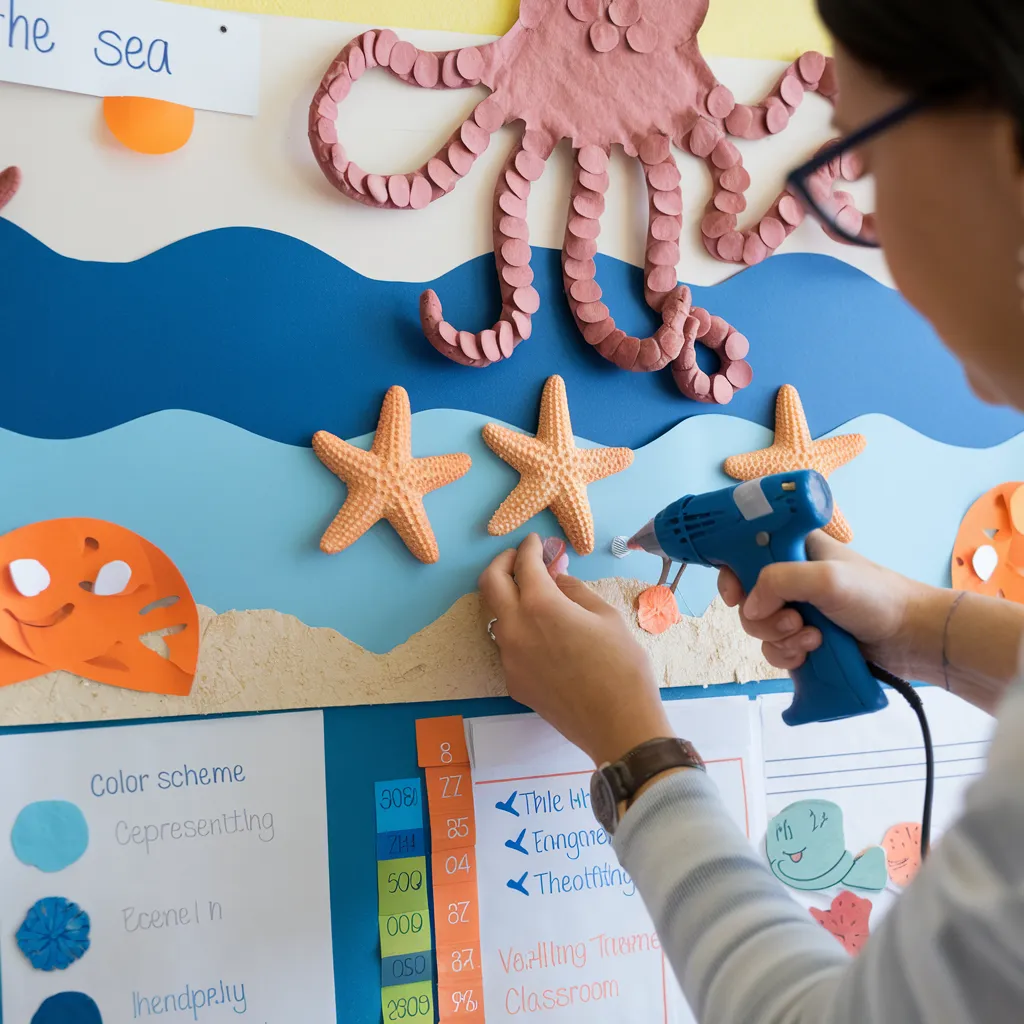Theme-based classroom decorations transform ordinary educational spaces into immersive learning environments that captivate student interest and enhance engagement. These coordinated design elements create cohesive atmospheres that support curriculum goals while making the classroom a more welcoming, stimulating place for students. Whether you’re a new teacher setting up your first classroom or a veteran educator looking to refresh your learning space, theme-based classroom decorations provide an organizational framework that ties together visual elements, learning centers, and instructional materials. From rainforest adventures to space exploration, thoughtfully selected classroom themes create memorable contexts that support learning objectives while generating excitement and curiosity among students of all ages.

Educational Benefits of Theme-Based Classroom Decorations
Theme-based classroom decorations offer substantial advantages beyond simply making the space look attractive:
Cognitive and Academic Impacts
- Content reinforcement: Thematic visuals strengthen retention of related information
- Background knowledge building: Environmental print supports concept development
- Vocabulary expansion: Theme-specific terminology becomes part of daily visual exposure
- Interdisciplinary connections: Themes naturally bridge different subject areas
- Contextual learning support: Abstract concepts become concrete through visual representation
Psychological and Social Benefits
Theme-based classroom decorations significantly affect student attitudes and behaviors:
- Classroom Community Building
- Shared theme creates common classroom identity
- Collaborative decoration projects build ownership
- Group investment in theme fosters belonging
- Theme-based roles and responsibilities support community
- Shared vocabulary and references strengthen connections
- Emotional and Behavioral Support
- Cohesive visual environment reduces sensory overload
- Organized theme reduces visual chaos and distraction
- Predictable thematic elements provide security
- Positive associations with theme increase comfort
- Theme-based expectations clarify behavioral norms
Popular Theme-Based Classroom Decorations by Category
Effective classroom themes generally fall into several broad categories:

Nature-Inspired Theme-Based Classroom Decorations
- Ocean and Marine Life
- Blue fabric ceiling waves create underwater feeling
- Fish and marine creature mobiles hanging from lighting
- Coral reef bulletin board borders with sea life facts
- Ocean depth zones displayed on wall charts
- Water cycle information integrated into design
- Rainforest and Jungle
- Leafy canopy created with green paper or fabric
- Vine garlands connecting different learning areas
- Rainforest layers labeled on wall displays
- Stuffed or paper tropical animals placed strategically
- Rainforest sounds playing during transition times
- Space and Astronomy
- Planet mobiles suspended from ceiling
- Star patterns created with glow-in-the-dark stickers
- Constellation fact cards on display boards
- Rocket ship reading nook with themed pillows
- Space mission control dramatic play area
Literature-Based Theme-Based Classroom Decorations
- Fairy Tales and Fantasy
- Castle-themed reading corner with stone-look bulletin board
- Character quotes as motivational displays
- Fantasy map wall showing story settings
- Magical creature spotlights with fiction/nonfiction facts
- Throne-style special occasion chair
- Favorite Book Series
- Chapter-themed learning centers
- Character cutouts as classroom helpers
- Setting backdrops for different subject areas
- Plot-point pathway along floor or walls
- Book quote borders for bulletin boards
Concept-Driven Theme-Based Classroom Decorations
- Growth Mindset and Motivation
- Brain growth displays showing learning progress
- « Power of Yet » statement wall with student work
- Challenge zone decorated with climbing/mountain imagery
- Mistake celebration area with positive reframing examples
- Inspirational quote changes tied to weekly skills
- Global Exploration
- World map focal wall with student connections marked
- International flags hanging as room dividers
- Cultural artifact display shelves with rotating items
- Global landmark reading corner with themed pillows
- Welcome messages in multiple languages
Creating Effective Theme-Based Classroom Decorations
Successful implementation requires thoughtful planning and execution:
Design Principles for Theme-Based Classroom Decorations

- Visual Hierarchy Considerations
- Create focal points that draw attention to key information
- Balance busy areas with visual rest spaces
- Use consistent color palette (3-5 colors) throughout theme elements
- Apply contrast principles to ensure readability
- Consider viewing angles and heights for different age groups
- Sensory-Friendly Approaches
- Limit overwhelming patterns in high-traffic areas
- Choose matte finishes to reduce glare
- Consider sound elements carefully (minimize noisy materials)
- Create sensory retreat spaces within themed environment
- Offer tactile elements that support rather than distract
Implementation Strategies for Theme-Based Classroom Decorations
- Budget-Conscious Approaches
- Focus investment on reusable foundation pieces
- Utilize digital printing for custom elements
- Engage parent volunteers for labor-intensive projects
- Source materials from dollar stores and clearance sales
- Create simple templates for hand-made repeated elements
- Time-Saving Techniques
- Design modular components that adapt between themes
- Create bulletin board backgrounds that work year-round
- Develop student-led decoration responsibilities
- Plan multi-year rotation of major theme investments
- Prepare seasonal theme modifications rather than complete changes
Adapting Theme-Based Classroom Decorations for Different Age Groups
Different developmental stages require specific considerations:

Early Childhood Theme-Based Classroom Decorations (PreK-2)
- Developmental Considerations
- Position key visuals at child eye level
- Incorporate manipulative elements children can touch
- Create dramatic play areas that extend theme
- Include simple text with supportive images
- Design floor space elements for circle time reinforcement
- Engagement Features
- Character-driven helper charts and job boards
- Theme-based sensory bins and exploration centers
- Oversized prop pieces for dramatic play
- Interactive wall elements children can modify
- Take-home extension components for family connection
Upper Elementary Theme-Based Classroom Decorations (Grades 3-6)
- Academic Integration
- Content-rich reference materials within themed design
- Question prompts integrated into decorative elements
- Student work showcases with themed framing
- Learning target displays with theme-based tracking
- Specialized vocabulary features within theme context
- Student Ownership Opportunities
- Co-created theme extensions by student committees
- Theme-based classroom jobs with greater responsibility
- Design challenges that enhance the classroom theme
- Interactive bulletin boards with student-created content
- Theme-based choice areas for independent work
Measuring the Impact of Theme-Based Classroom Decorations
Evaluate effectiveness through multiple lenses:
Assessment Approaches
- Student Feedback Collection
- Entry/exit slips about classroom environment
- Drawing activities showing favorite classroom areas
- Simple survey tools about theme engagement
- Discussion circles focused on environment
- Photo documentation with student captions
- Observational Data Gathering
- Traffic pattern monitoring in themed areas
- Engagement timing in different spaces
- Social interaction mapping across classroom zones
- On-task behavior comparison in various areas
- Thematic vocabulary usage in student discussions
Conclusion
Theme-based classroom decorations offer a powerful strategy for creating cohesive, engaging learning environments that support both academic goals and student well-being. By thoughtfully selecting themes that align with curriculum, student interests, and developmental needs, educators can transform ordinary classrooms into extraordinary spaces that inspire curiosity and foster community. Whether implemented on a grand scale or through simple coordinated elements, theme-based approaches provide an organizational framework that enhances the educational experience for both students and teachers. Begin by selecting a theme that genuinely excites you, gathering key foundational pieces, and gradually building your themed environment with both purchased and created elements. Remember that the most effective classroom themes balance visual appeal with instructional purpose, creating spaces where learning naturally flourishes within a supportive, stimulating context.
45 Captivating Animal Theme Learning Printables That Transform Education
Frequently Asked Questions
How often should I change theme-based classroom decorations?
Major classroom themes typically work best when maintained for at least one semester or full academic year, allowing students to develop deep connections with the environment while giving teachers full return on their preparation investment. However, you can refresh the theme periodically with seasonal modifications, student-created additions, or theme extensions that maintain the core concept while introducing novelty. Many teachers successfully use a multi-year rotation of 2-4 major themes, with minor updates each time they reappear. The best approach balances consistency (which provides security and familiarity) with appropriate novelty (which stimulates interest and reflects current learning).
How do I create theme-based classroom decorations on a tight budget?
Focus first on foundational elements that create big visual impact with minimal expense—like solid-color bulletin board backgrounds, simple borders, and strategic fabric panels for large areas. Prioritize reusable items that can transition between themes or serve multiple purposes. Engage students in creating decorative elements through art projects that double as learning activities. Source materials from dollar stores, thrift shops, and parent donations, keeping a running wish list for specific items. Many effective themes begin with just 3-5 key purchased elements supplemented with teacher-created and student-generated components. Remember that cohesive color schemes and thoughtful arrangement often create more visual impact than quantity of decorations.
How can I ensure theme-based classroom decorations don’t distract from learning?
Create deliberate visual hierarchy by distinguishing between background thematic elements (which set the atmosphere) and instructional focal points (which demand attention). Avoid placing highly detailed or movement-oriented decorations near direct instruction areas. Implement a « learning first » filter—each decorative element should either directly support specific learning objectives or create general environmental positivity without competing with instructional focus. Consider using more elaborate thematic elements in break areas, entrances, and transitions zones, while keeping work areas visually simpler. The most effective theme-based classrooms balance engagement with appropriate restraint, creating environments that stimulate interest without overwhelming students’ attentional capacity.
How do I incorporate classroom themes without making my room look cluttered?
Adopt the design principle « less is more » by selecting fewer, more impactful thematic elements rather than filling every available space. Maintain substantial areas of « visual rest » with solid colors or simple patterns. Create clear organizational zones with consistent visual boundaries. Use coordinated colors throughout your theme to create coherence without complexity. Consider vertical space thoughtfully, avoiding the temptation to cover every wall surface. Regularly evaluate your classroom from the student perspective (literally sitting at their level) to assess visual overload. The most effective themed classrooms often feel immersive not because every inch is decorated, but because strategic elements create a cohesive atmosphere with room to breathe.
How can I involve students in creating theme-based classroom decorations?
Start by soliciting student input on theme selection or elements through simple voting or discussion activities. Create « decoration stations » during the first week of school where students contribute to specific theme components. Assign classroom areas to small groups for theme development with teacher guidance. Integrate decoration creation into academic lessons—writing for display materials, math for measurement and pattern elements, science for accurate themed models. Establish ongoing theme committees with rotating membership to refresh and maintain areas throughout the year. The most successful student involvement balances teacher-established framework with meaningful student contributions, creating true ownership while maintaining visual and functional coherence.
